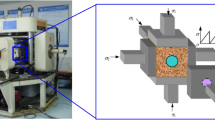Abstract
It is well known, that the strength of rocks depends on the strain or stress rate. Increasing the stress or strain rate, the strength of the rock material is increasing. The goal of this paper is to present a theoretical background of this behavior. A laboratory method is suggested to determine the critical dissipated energy density (CDE) of homogeneous-isotropic rock. In case of uniaxial compression it can be calculated easily with the difference of the work done by the external force and the energy connected to the change of structure. These energies can be measured by applying different stress or strain rates, if they tend to infinite and zero. It was assumed, that the Poynting-Thomson (standard) model can be used for modeling the rheological behavior of the intact rock, and this model was applied determining the critical dissipated energy density. The uniaxial compressive tests were carried out for both “infinite” and “zero” stress rates, and the measured stress-strain curves were compared and analyzed.
According to the results, the critical dissipated energy per unite volume can be used as a material constant: it is influenced by the texture of the rock, internal bonds, the cohesion, the strength of the minerals, the porosity, etc. Using seven different types of rocks the critical dissipated energy per unite volume was determined and the relationship with the compressive and tensile strength, ultrasonic wave velocity and porosity was calculated. Knowing this critical dissipated energy, probably the tunnel stability can be calculated easier, or it can be used in the calculation of the earthquakes damage, among others.







Similar content being viewed by others
References
Andreev GE (1995) Brittle failure of rock materials—test results and constitutive models. Balkema, Rotterdam
Asszonyi Cs, Richter R (1979) The continuum theory of rock mechanics. Trans. Tech. Publications, Clausthal
Bieniawski ZT (1967) Mechanism of brittle fracture of rock, part I, II and III. Int J Rock Mech Min Sci 4:395–430
Gálos M (1982) Evaluation of creep tests for rock. In: Proc 4th int cong engng geol, New Delhi, vol III, pp 201–204
Houpert R (1979) The fracture behaviour of rocks. In: Proc 4th int cong rock mech, Montreaux, vol 3, pp 107–114
ISRM (1978) Suggested methods for determining tensile strength of rock materials. Int J Rock Mech Min Sci Geomech Abstr 15:99–103
ISRM (1979) Suggested methods for determining the uniaxial compressive strength and deformability of rock materials. Int J Rock Mech Min Sci Geomech Abstr 16:135–140
Lin W, Kuwahara Y, Satoh T, Shigematsu N, Kitagawa Y, Kiguchi T, Sato T, Tsukamoto H, Itaba S, Umeda Y, Seki Y, Takahashi M, Matsumoto N, Koizumi N (2010) A case study of 3D stress orientation determination in Shikoku Island and Kii Peninsula, Japan. In: Vrkljan I (ed) Proceedings of Eurock’09 cavtat, rock engineering in difficult ground conditions (soft rock and karst), Croatia, 2009. Balkema, London, pp 277–282
Martin CD, Chandler NA (1994) The progressive fracture of Lac du Bonnet granite. Int J Rock Mech Min Sci Geomech Abstr 31(6):643–659
Matsuki K (2008) Anelastic strain recovery compliance of rocks and its application to in situ stress measurement. Int J Rock Mech Min Sci 45:952–965
Matsuki K, Takeuchi K (1993a) Three-dimensional in situ stress determination by anelastic strain recovery of a rock core. Int J Rock Mech Min Sci Geomech Abstr 30:1019–1022
Matsuki K, Takeuchi K (1993b) Three-dimensional in-situ stress determination by anelastic strain recovery of a rock core. In: 34th US symp rock mech (USRMS), 28–30 June 1993, Madison, WI, ID 93-0637
Ván P, Szarka Z (2006) Rock rheology—time dependence of dilation and stress around tunnel. In: van Cotthem A, et al. (eds) EUROCK 2006, Liege, pp 357–364
Vásárhelyi B, Deli Á, Gálos M, Ván P (2000) Relationship between the critical dissipated energy per unit volume and the mechanical properties of different rocks. In: Girard J, Liebman M, Breeds C, Doe T (eds) Pacific rocks 2000. Proc 4th NARMS, Seattle, pp 1289–1293
Verhás J (1997) Thermodynamics and rheology. Akadémiai Kiadó and Kluwer Academic, Budapest
Zhifa Y, Zhiyin W, Luqing Z, Ruiguang Z, Nianxing X (2001) Back-analysis of viscoelastic displacement in soft rock road tunnel. Int J Rock Mech Min Sci 38:331–341
Author information
Authors and Affiliations
Corresponding author
Rights and permissions
About this article
Cite this article
Deli, Á., Gálos, M. & Vásárhelyi, B. A laboratory method for determining the dissipated energy. Acta Geod Geophys 48, 77–86 (2013). https://doi.org/10.1007/s40328-012-0007-z
Received:
Accepted:
Published:
Issue Date:
DOI: https://doi.org/10.1007/s40328-012-0007-z




